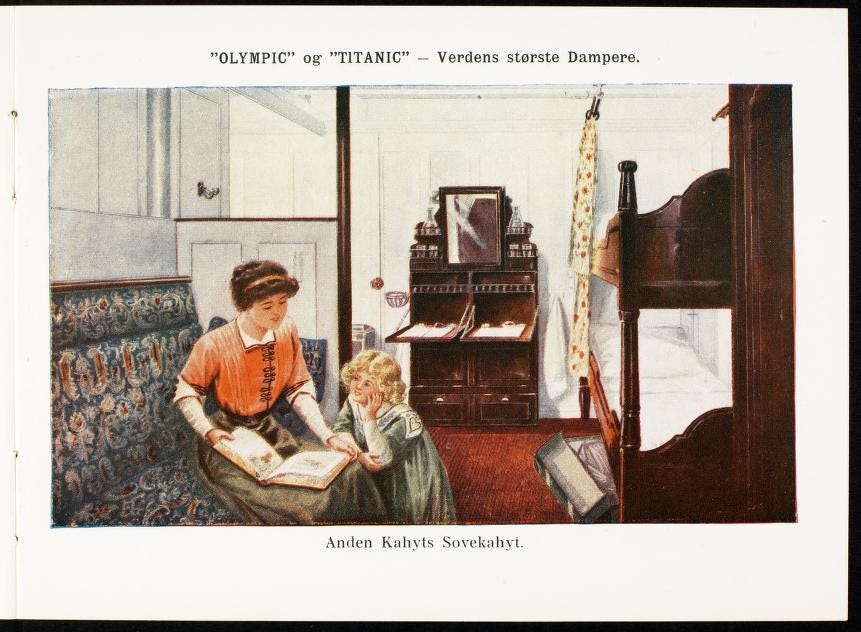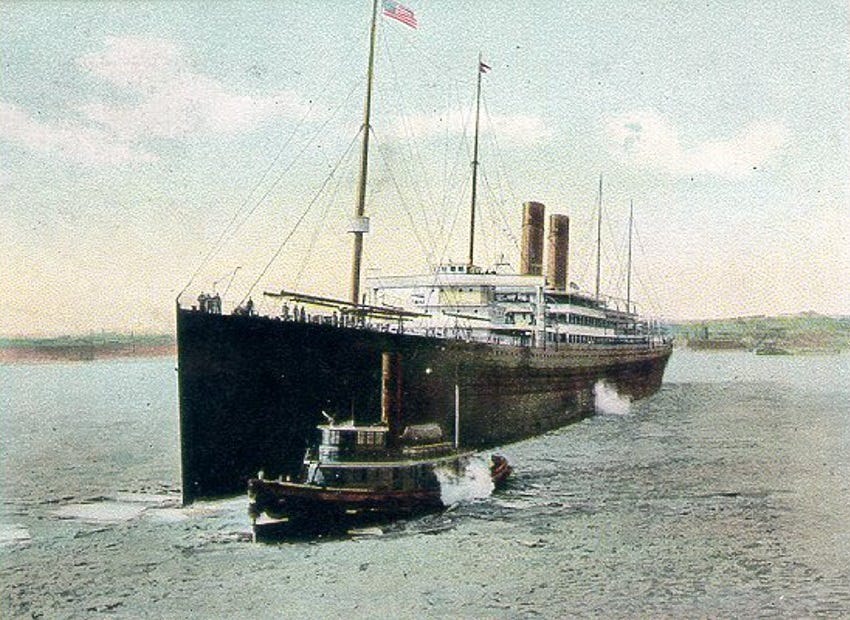When I looked further into the story of third class Titanic passenger Anthony Abbing, who was born in the United States, I became interested in finding the details of his original journey from America to Europe. American born third class passengers shared the commonality that they had experienced a trans-Atlantic journey prior to the Titanic voyage. For this week’s post, I will discuss Abbing’s voyage to Europe as well as details of the journeys to Europe of other American born third class passengers on the Titanic.
Anthony (Tony) Abbing
Abbing was 41 at the time he boarded the Titanic.
Born in Cincinnati, Ohio, he had become a well known wrestler in the city and eventually traveled to England and then Johannesburg, South Africa, with fellow athlete friends. He rode the ship Germanic from New York to Liverpool, and then went to South Africa on the ship Warwick Castle. An article from the Cincinnati Enquirer dated June 8, 1896 announced his intended journey:
“A trio of athletes, two from Cincinnati and one from Chicago, will leave Sunday night for far-off South Africa. Tempted by the stories of the rich prizes to be had in that far-off clime, Bob Carlos, the well-known lightweight wrestler, of this city, and Tony Abbing, the crack heavyweight wrestler, also of this city, have decided to go to Johannesburg. They will be accompanied by George Goeble of Chicago.”
“Abbing and Carlos will more than hold their own in the wrestling line in pretty nearly any kind of company. Both have won their spurs by meritorious work in the vicinity, and if there are any purses offered in that country they will come near getting them. Their long journey will not be in vain even if they do not succeed in getting any matches. Both are practical workmen. Carlos is a good machinist and Abbing a carriage blacksmith. They will leave for New York Wednesday night. They will sail to Southampton and then take the Castle Line to Cape Town."1
Abbing did not survive the sinking.
Eugene Joseph Abbott
Eugene Abbott, born in Providence, Rhode Island, was 13 at the time of the Titanic sinking.
Almost two years prior to that, in August of 1911, Eugene arrived in Southampton, England, from New York along with his mother and brother on the Titanic’s sister ship, the Olympic.
On the Olympic, the Abbotts would have experienced high standards of travel in third class, similar to their future journey on the Titanic. The triad had traveled to England with the intention of staying there after Eugene’s mother, who was originally born in England, divorced from his father.
Tragically, Eugene and his brother Rossmore died in the Titanic sinking while his mother Rhoda survived.

Laura May Cribb
Laura May Cribb, born in Newark, New Jersey, was 16 at the time of the Titanic sinking. Laura had two documented travels from America to Europe, one in 1899 on the S.S. New York with her family to England and one in September 1904 aboard the Cedric of the White Star Line. Due to Laura’s ill health and bad reaction to the New Jersey polluted air, she had traveled with her mother and siblings to rural England where her parents had once lived.
Laura survived the Titanic sinking while her father died.
Elizabeth Dowdell and Virginia Ethel Emanuel
Elizabeth Dowdell, born in Hoboken, New Jersey, was 31 at the time of the Titanic sinking. Virginia Ethel Emanuel, born in New York, New York, was 6. Elizabeth served as a nursemaid to the young Virginia.
Virginia’s mother was an opera singer by the name of Elise Martin. Elizabeth and Virginia had the experience of traveling on the Titanic’s sister ship Olympic in the second class cabin on their trip to Europe with Virginia’s mother, who traveled in first class. Then the two returned together without Elise on the Titanic, traveling in third class.
Both Elizabeth and Virginia survived the Titanic disaster.

Anna Elisabeth Judith Dyker
Anna Elisabeth Judith Dyker, born in Worcester, Massachusetts, was 22 at the time of the Titanic sinking. She and her husband Adolf Frederick Dyker traveled on the Cunard liner Campania from New York to Liverpool in December of 1911. Adolf worked as a tram conductor and Anna, who had attended Yale music school, was a singer and music teacher. The couple was traveling to Sweden to settle the estate of Adolf’s father who had died in December of 1911. Their travel on the Campania differed from their later travel on the Titanic as the accommodations on the Campania were for the third class passengers to eat and sleep in a state room with twelve bunk beds while on the Titanic they had a separate dining room from their sleeping quarters.2
While Anna survived the sinking of the Titanic, her husband did not.
Jennie Louis Hansen
Jennie Louis Hansen, born in Racine, Wisconsin, was 45 at the time of the Titanic sinking. She and her husband Claus Peter Hansen sailed on February 14, 1912, on the Campania from New York to Liverpool, England, and then to Denmark to visit her husband’s parents and three brothers who he had not seen in twenty-one years.
Jennie survived the Titanic sinking while her husband passed away.
William Cahoone Johnson and August Johnson
William Cahoone Johnson, born in Newark, New Jersey, was 19 at the time of the Titanic sinking. August Johnson, born in New York, New York, was 49. Both men would have made several transatlantic voyages as they were seamen on the American Line’s Philadelphia. The reason they traveled on the Titanic was due to the cancellation of the western trip of the Philadelphia resulting from a coal strike going on in Britain at the time. According to The Morning Call of Paterson, New Jersey, William Cahoone Johnson was serving as a fourth-quarter master on the Philadelphia.3
Both men died in the sinking of the Titanic.
Francis Rice
Francis Rice, born in Spokane, Washington, was 2 at the time of the Titanic sinking. His parents were originally from Ireland. In January of 1910, his father William was crushed by a train engine while working on the Great Northern Railway in Hillyard outside of Spokane, Washington. In May 1910, Francis, who was listed as Eugene on the passenger list, traveled with his mother and four brothers from Montreal, Canada, to Liverpool via the White Star Dominion Line and from there traveled to Ireland. It was noted that this shipping line offered more private cabins than most steerage accommodations of the time as well as reading and smoking rooms, dining rooms with linen and silverware, and menu cards with postcards on their back to send to relatives.

Sadly, Francis, all of his siblings, and his mother died in the sinking.
Beatrice Irene Sandstrom and Marguerite Rut Sandstrom
Beatrice Irene Sandstrom, born in San Francisco, California, was 1 at the time of the Titanic sinking. Marguerite Rut Sandstrom, born in Chicago, Illinois, was 4. Their parents had emigrated to America in 1906 where her father worked as an iron worker and as a merchant. In August of 1911, the sisters and their mother traveled from New York to Liverpool on the White Star Liner the Celtic in order to visit her mother’s family and friends in Sweden.
Both sisters as well as their mother survived the sinking of the Titanic.
Next week’s post will continue the focus on American born third class Titanic passengers.
“Off for South Africa, A Trio of Athletes Start for that Far Off Country,” The Cincinnati Enquirer, June 8, 1896
Lucania and Campania, steerage accommodation, Norway Heritage.
“Met Death Like A Hero,” The Morning Call, Paterson, New Jersey, May 3, 1912.
Additional Sources:
Ancestry.com Passenger lists
Encyclopedia Titanica






I'm fascinated by the families that traveled back and forth multiple times like Laura Cribb's family. I think of immigration at that time being one way, one time only, and I guess that's a misconception.
One thing I want to add about one of these stories is that Rhoda Abbott was the only woman who survived without getting into a lifeboat by grabbing onto a collapsible boat in the water. She held onto her sons until the very end but they were swept away from her. Just to clarify that she didn't board a lifeboat without them.